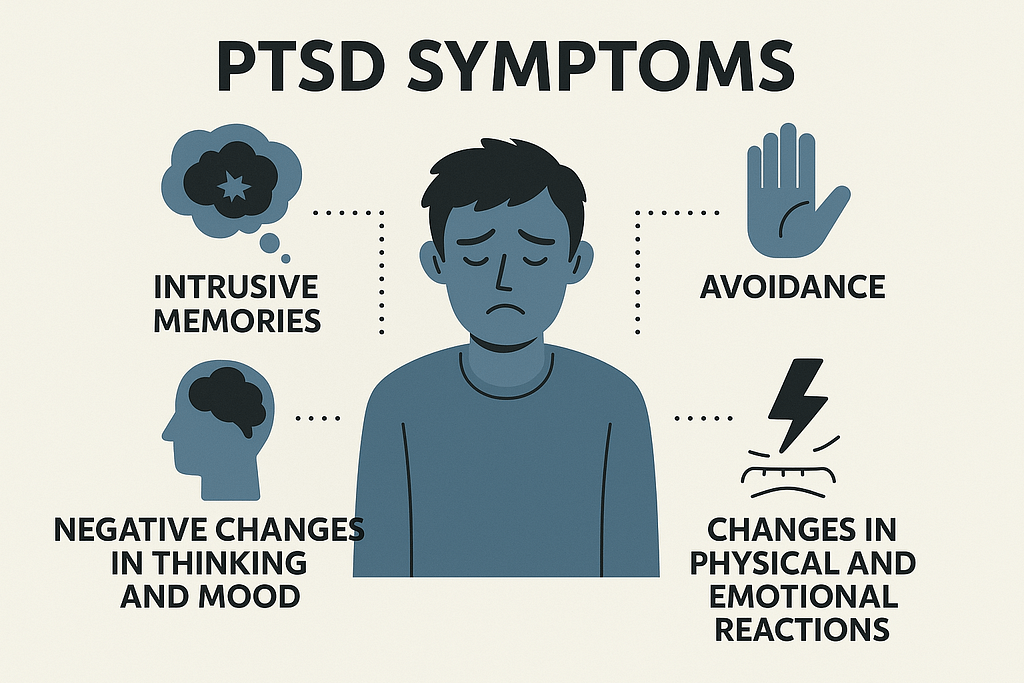
Post-Traumatic Stress Disorder (PTSD) can quietly impact your life long after a traumatic experience. It doesn’t always show up immediately, and its symptoms may feel confusing or even unrelated to the trauma itself. That’s why understanding PTSD symptoms and when to get help is so important for yourself or someone you care about.
This guide breaks down what PTSD looks like, how it feels, and what signals it’s time to talk to a professional.
What Is PTSD? A Simple Definition
PTSD is a psychological condition that may arise after someone endures or observes a deeply distressing or traumatic experience.
Events that may cause PTSD include:
- Physical or sexual assault
- Combat exposure
- Natural disasters
- Serious accidents
- Childhood abuse or neglect
- Witnessing violence or death
Though some trauma responses are temporary, PTSD symptoms often linger for months or even years, especially if untreated.
Common PTSD Symptoms You Shouldn’t Ignore
PTSD affects people differently. Symptoms can start days, weeks, or even years after the traumatic event.
Here are the four main categories of PTSD symptoms:
1. Intrusive Memories
These include:
- Flashbacks (feeling like you’re reliving the trauma)
- Nightmares or disturbing dreams
- Upsetting thoughts that are hard to control
- Emotional distress when reminded of the event
These experiences can feel overwhelming and unpredictable.
2. Avoidance Behaviors PSDT symptom
People with PTSD often make significant efforts to steer clear of anything that reminds them of their traumatic experience:
- Avoiding people, places, or situations that remind them of the event
- Refusing to talk about the trauma
- Withdrawing from activities and social connections
Avoidance may offer temporary relief, but it often worsens symptoms over time.
3. Negative Changes in Mood and Thinking
Trauma doesn’t just affect how you act; it impacts how you think and feel:
- Feelings of hopelessness or despair
- Trouble remembering parts of the traumatic event
- Loss of interest in once-enjoyed activities
- Emotional numbness or detachment
- Constant guilt or shame
These changes can lead to isolation, depression, and a distorted self-image.
4. Changes in Physical and Emotional Reactions
PTSD often leads to what’s called hyperarousal, your body stays in “fight or flight” mode:
- Being easily startled or frightened
- Difficulty sleeping
- Angry outbursts or irritability
- Difficulty concentrating
- Reckless or self-destructive behavior
These symptoms can disrupt daily routines, work, and relationships.
How PTSD Symptoms Affect Daily Life
Living with PTSD doesn’t just affect your inner world—it has a ripple effect on everything:
| Area of Life | Common Impact |
| Relationships | Emotional distance, arguments, and mistrust |
| Work/School | Missed deadlines, absenteeism, difficulty focusing |
| Physical Health | Sleep disorders, chronic pain, fatigue |
| Mental Health | Anxiety, depression, panic attacks, and substance abuse |
This is why recognizing PTSD symptoms and when to get help is so essential—not just to feel better, but to live better.
When to Get Help for PTSD Symptoms
It’s time to seek help if:
- Symptoms last longer than one month
- They interfere with your daily life
- You avoid more and more situations
- You feel disconnected from others
- You’re using substances to cope
- You’ve had thoughts of harming yourself or others
Even if you’re unsure whether you “qualify” for PTSD, don’t wait until things get worse. If you’re suffering, help is justified.
Who to Turn to for Help
The good news? You’re not alone, and help is available.
Mental Health Professionals:
- Psychologists and therapists offer talk therapy, like CBT or EMDR.
- Psychiatrists can diagnose PTSD and prescribe medication if needed.
Support Resources:
- Your primary care doctor can help connect you with qualified mental health professionals.
- Crisis helplines and online chat services are available 24/7, providing immediate support whenever you reach out.
- Peer support groups connect you with others who understand.
Emergency Help:
If you’re feeling suicidal or unsafe, call or text a local crisis line or go to the nearest emergency room. In the U.S., dial 988 for the Suicide & Crisis Lifeline.
Benefits of Getting Help Early to Deal with PTSD Symptoms
Seeking support early improves outcomes and makes recovery easier. Benefits include:
- Better sleep
- Reduced anxiety and panic
- Improved relationships
- Greater control over emotions
- Renewed sense of hope
Keep in mind, PTSD is treatable, and with the right support, healing isn’t just possible, it’s highly achievable.
Common Myths That Prevent People from Getting Help
Breaking these myths can be the first step toward recovery:
- Myth: “Only soldiers get PTSD.”
Truth: Anyone who experiences trauma can develop PTSD. - Myth: “If I simply push it aside, it will go away on its own.”
- Truth: Without proper treatment, PTSD symptoms usually intensify over time rather than fade away.
- Myth: “Talking about it makes it worse.”
Truth: With proper guidance, talking is part of the healing process. - Myth: “I should be over this by now.”
Truth: There’s no timeline for healing. Everyone’s journey is unique.
Coping Strategies While You Seek Professional Help
While professional support is crucial, here are some ways to manage symptoms in daily life:
- Practice deep breathing or mindfulness
- Stay physically active to release stress
- Keep a journal to track triggers and feelings
- Stay connected with trusted friends or family
- Create a calming bedtime routine
These practices don’t replace therapy but can help stabilize your emotions between sessions.
FAQs About PTSD Symptoms and When to Get Help
1. How long do PTSD symptoms last before I should get help?
If symptoms persist beyond four weeks or interfere with your daily life, it’s time to seek help.
2. Is it possible for PTSD symptoms to emerge long after the traumatic event?s
Yes, delayed-onset PTSD can occur months or even years after the event, especially if triggered by stress or reminders.
3. What if I don’t remember everything about the trauma?
You don’t need to remember every detail to get help. Therapists are trained to support you, no matter what you recall.
4. Are there medications for PTSD?
Yes. Some antidepressants and anti-anxiety medications are effective in reducing PTSD symptoms when prescribed by a professional.
5. Is PTSD permanent?
Not at all. With the right treatment, many people recover fully or manage symptoms so they no longer control their lives.
6. What if I’m afraid to talk about what happened?
That’s normal. A good therapist will go at your pace and create a safe, supportive environment.
Conclusion: Healing Starts with Recognizing the Signs
Understanding PTSD symptoms and when to get help is the first and most important step in taking back control of your life. Whether you’ve recently experienced trauma or have been struggling for years, remember—help is out there, and you deserve it.
You don’t have to live in survival mode forever. By recognizing the signs and reaching out, you open the door to peace, clarity, and healing.
